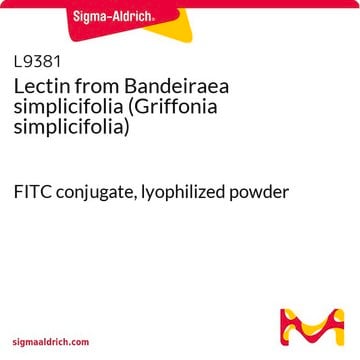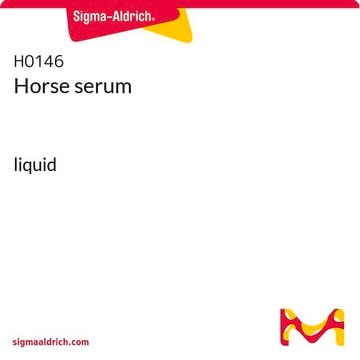L2895
Lectin from Bandeiraea simplicifolia (Griffonia simplicifolia)
Isolectin B4 (BSI-B4), FITC conjugate, lyophilized powder
Sinónimos:
Bandeirea simplicifolia agglutinin, BS-I
About This Item
Productos recomendados
conjugado
FITC conjugate
Nivel de calidad
formulario
lyophilized powder
potencia
<50 μg per mL agglutination activity (using human blood group B erythrocytes)
composición
Protein, ≥70% Lowry (balance sodium citrate)
Extensión del etiquetado
≥1 mol FITC per mol lectin
temp. de almacenamiento
2-8°C
¿Está buscando productos similares? Visita Guía de comparación de productos
Categorías relacionadas
Descripción general
Aplicación
Acciones bioquímicas o fisiológicas
Envase
Otras notas
Nota de análisis
Código de clase de almacenamiento
11 - Combustible Solids
Clase de riesgo para el agua (WGK)
WGK 3
Punto de inflamabilidad (°F)
Not applicable
Punto de inflamabilidad (°C)
Not applicable
Equipo de protección personal
Eyeshields, Gloves, type N95 (US)
Certificados de análisis (COA)
Busque Certificados de análisis (COA) introduciendo el número de lote del producto. Los números de lote se encuentran en la etiqueta del producto después de las palabras «Lot» o «Batch»
¿Ya tiene este producto?
Encuentre la documentación para los productos que ha comprado recientemente en la Biblioteca de documentos.
Los clientes también vieron
Nuestro equipo de científicos tiene experiencia en todas las áreas de investigación: Ciencias de la vida, Ciencia de los materiales, Síntesis química, Cromatografía, Analítica y muchas otras.
Póngase en contacto con el Servicio técnico










